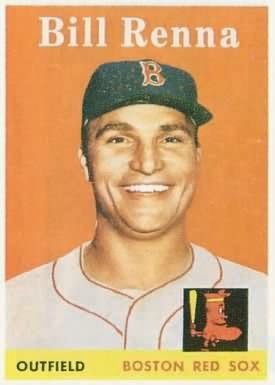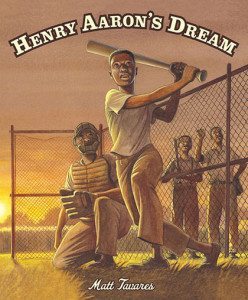Bill Renna died in June at age 89.
Boston Red Sox
Author-illustrator Matt Tavares Creates A Winning Ted Williams Book For Kids
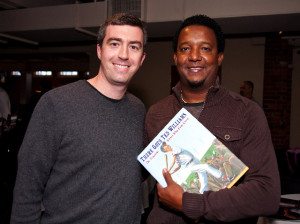 |
| Matt Tavares (left) and Pedro Martinez, both signing autographs at a Jimmy Fund fundraiser (Photo courtesy www.MattTavares.com) |
Matt Tavares is bringing baseball history to a new generation.
The talented author-illustrator’s latest creation is There Goes Ted Williams: The Greatest Hitter Who Ever Lived (Candlewick Press). I’m thankful to Matt, who agreed to share his own history as a fan and occasional collector.
Q: I love your book Zachary’s Ball. How were the Red Sox autographs collected in the book for the First Book fundraiser? Had you ever tried collecting autographs, in person or TTM, before?
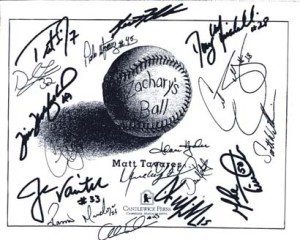 |
| (Image courtesy www.MattTavares.com) |
A: During the 2004 season, Trot Nixon’s wife was involved with First Book, a great organization that provides books for children in low income families. I’m not sure if it was her idea or someone else’s, but I think she basically just asked Trot to pass the book around the clubhouse and have everybody sign it, so they could auction it off to raise money for First Book. I didn’t even know about it until after the book had been signed. Conveniently, the Red Sox went on to win the World Series that year, which made the book even more special. My publisher, Candlewick Press, is also involved with First Book, so they helped out with the auction. It sold for about $2000!
Q: As an illustrator (but someone who might be asked to sign hundreds of in-person autographs at a bookstore or school visit) what were your thoughts of the legibility of Red Sox autographs?
Q: You mention your Dad in your Author’s Note for the great book, There Goes Ted Williams. What’s your fan history, including Boston games you attended (with him, and later)?
A: I grew up in Winchester MA, a suburb of Boston. My dad took me to a few Red Sox games a year when I was a kid. And of course, I watched tons of games on tv. I always brought my glove, and always wanted to catch a foul ball. In 1990, when I was a sophomore in high school, the Red Sox just needed to win one game in their final series against the White Sox to clinch the division, so my dad bought tickets to all three games, figuring we’d keep going until they clinched. They lost the first game, lost the second game, and finally won it in the final game of the season. That was the game Tom Brunansky made that amazing diving catch near Pesky’s pole to end it. I was sitting in right field in section 7, row 11 (I thought that was good luck). That was one fun and exhausting week! I’ve been to some other big games… the 1999 Red Sox-Yankees ALCS game 3, Clemens vs. Pedro, as well as games 4 and 5 in the ALDS against the Indians that year. Lots of great Fenway memories over the years…
These days, living in southern Maine, I go to more Portland Sea Dogs games than Red Sox games. Portland is the AA affiliate of the Red Sox, so it’s fun to follow the Sea Dogs, then when the players get called up to the majors I already know them.
Q: I know that Cal Ripken Jr. and the late Gary Carter have championed children’s books, encouraging more kids to read. Are there past or present baseball names who’ve communicated with you?:
A: My baseball books have been used by The Massachusetts Teachers Association a few times for their Red Sox Reading program. Through that, I’ve gotten to meet Trot Nixon, Derek Lowe, and Jason Varitek, who were all involved with the program over the years. Recently I signed books at a Jimmy Fund fundraiser where Pedro Martinez was signing, so I got to meet him. I was so excited, I felt like a little kid
Q: For either your Henry Aaron or Ted Williams books, did you correspond with any baseball names (teammates, foes, media, etc.) for your research?
A: Right now I’m working on a picture book biography of Babe Ruth’s early years, tentatively titled Becoming Babe Ruth, due out in Spring 2013, published by Candlewick Press.
—
I’m grateful to Matt for postponing deadlines to share his own baseball biography. If you want to share the love of the game with young people, start with his books. Like him on Facebook to be eligible for monthly prizes. He gives away an autographed book. For the Aaron book, he added an original sketch of the slugger with his autograph. See it, and learn more at www.matttavares.com
Coming Monday: How to help a former player in need.
Red Sox Pitcher ‘Boo’ Ferriss Shares Blessings
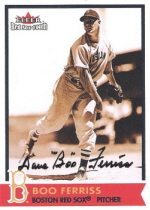 |
| From the 2001 Anniversary Set. Ferriss keeps amazing collectors! |
Boston Red Sox pitcher Dave “Boo” Ferriss hasn’t been on the mound in more than 60 years. However, he isn’t done thanking collectors and fans.
Even six decades later, he still averages “5 to 7” autograph request letters weekly. I asked him about his devotion to signing.
“If fans think enough of me to sign for them, I think I am obligated to honor their requests. Baseball would be nothing without great fans filling the park.”
I wrote to Ferriss to see what collectors could do for him. How could we show our gratitude?
“I’m not seeking paybacks from collectors and fans. I just enjoy knowing about their love of the game.
In the past, some collectors on their own initiative have sent me donations for the support of the Delta State University Baseball Program where I enjoyed coaching 26 years. I got great enjoyment of coaching young men in college baseball, greatly rewarding.
Any such donations should be made to the delta State University Foundation, designated for the baseball program that I am still closely associated with. Gifts should be sent to me and they are tax deductible.”
No regrets. No bitterness over what might have been. This is a man filled with joy and gratitude.
“I try to give back to baseball in any way I can, for the game has been good to me and has enriched my life. The game has given me endured friendships and associations that are priceless.
The Lord has blessed me in a tremendous way.
Thanks for your very kind letter.
Best regards,
Boo Ferriss”
Ferriss remains an autograph all-star, still stunning those who write the man awaiting his 90th birthday Dec. 5.
Want to know more about this amazing alum from Fenway Park? Enjoy this fine profile by Rick Cleveland, who captured Ferriss’s career and life in book form.
Write Ferriss at
510 Robinson Dr., Cleveland, MS 38732
Thank him for his service during World War II, too. This “Boo” should be celebrated all year long, not just on Halloween.
Boston Red Sox Pitcher Bob Heffner Shut Out 1964 Yankees For Baby Daughter!
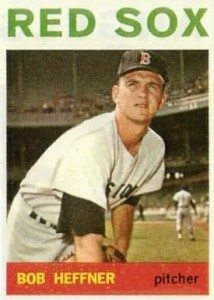 |
| Face of a Yankee tamer! |
Pitcher Bob Heffner found two reasons to celebrate on Aug. 21, 1964.
Before a grateful Fenway Park Crowd of 28,830, Heffner tamed the rival New York Yankees. It wasn’t an ordinary win, nor was it an average day. As Heffner wrote…
“My 6-hit shutout over the Yankees in 1964 was on my baby daughter’s first birthday. The rivalry between the new York Yankees and the Boston Red Sox in 1964 was just as intense as it is today.”
(Thanks for the details, http://www.retrosheet.org/!)
Heffner’s first celebration as a Red Sox came in 1963. He remembered:
“I learned I got my first start in the major leagues when I arrived in Boston from the AAA Seattle Rainiers club. My father flew in from Allentown and we celebrated after the win with a cold beer.”
That same year, Heffner became only the second major league pitcher ever to record three putouts in an inning. What does Heffner recall of that history from June 28, 1963?
“Regarding my record three putouts in one inning in 1963, all the balls were hit toward the first baseman. In spring training, we were always told to cover first base.”
Baseball fundamentals make history? Stranger things have happened.
Coming Monday: a moment with Yankee pitcher Johnny Kucks.
Negro Leagues Collector Cam Perron Moves From Autographs To History-Making Friendships
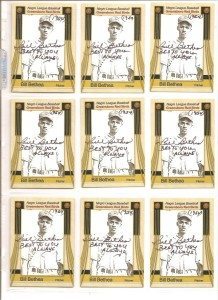 |
| One of Cam Perron’s first creations to assist a Negro Leaguer |
Cam Perron may be signing an autograph for you soon.
This amazing 16-year-old collector has moved from mere autographs to becoming a respected researcher and advocate for Negro Leaguers. Making cards. Helping a retiree qualify for a Major League pension. Organizing a reunion in Alabama for league survivors. He’s getting everyone’s attention, even telling Boston Red Sox players about these baseball pioneers he’s reconnected with the sport and hobby. The official team website video is testament to Perron’s passion.
I received two glowing endorsements of Perron, the first from Audrey Vernick, author of a fine biography of Hall of Famer and Negro Leagues team owner Effa Manley. Subsequently, Kyle Smego of always-stunning website “The Autograph Addict” shared the Red Sox video and his praise.
I was delighted to get Perron’s e-mail responses to my questions. His stories amaze and inspire me!
Q: When did you progress from a letter asking for an autograph, to a letter asking questions or more? What’s a typical letter like today to a Negro Leaguer for you? Have you been able to ask specific questions about teammates or past seasons?
A: Once I started getting more into the researcher, over just getting autographs, I began asking players certain questions in the letters. I would ask if they had any photos, stayed in touch with any teammates, and I would pretty much just drill them with questions in order to find out as much as possible.
I don’t really have a typical letter I send to negro leaguers any more. 99% of the time I speak with them on the phone first to explain to them what I’m doing, etc. When I write to them I write a note saying that
“I am the person they spoke with on the phone, enclosed are some photos and articles from your career, some phone numbers and other info. I have enclosed 2 baseballs and some index cards I would like you to sign.” Then I draw a diagram of a baseball and how they should sign it with blue pen on the sweet spot. Most players have never signed a ball since they played, and they don’t know how to make it look nice. Many signed on the Bud Selig signature, or sign through the seams if not told otherwise.
Yes, I have been able to ask specific questions about teammates and past seasons. After speaking with a player a few times, (I’m primarily taking about the players that I’ve tracked down and no one has ever spoken with before), I usually ask them if they remember any teammates and where they were from, from a specific season etc.. I ask them as many questions as possible to get as many names as possible out of them. More names = more players I can find.
Q. What about collectors who’d think: “How do you write to a Negro Leaguer? Aren’t they bitter at the bigotry, that they never got to play in the majors?” What are examples of happy memories you’ve gotten from Negro Leaguers by mail?
A: There are a few ball players who are disappointed that they were never recognized and never make the majors , and 99% of the time, those are the guys who won’t sign through the mail. Those type of guys want nothing to do with their careers, therefore never sign and are tough to deal with if you’re talking about baseball. I’ve spoken with many ballplayers who are the nicest guys in the world, but when it comes to baseball it is a very delicate subject for them. Many ballplayers like to sign and those guys I will give their addresses out with permission. They will sign ttm, sometimes for a few bucks.
As for happy memories, I’ve gotten hundreds of letters back from ballplayers thanking me for everything. I’ve had 100s of players call the house after they receive a package from me. Many times players think I am just doing a school project or something, but when they receive the packages I send to them, their attitude totally changes. I’ve had players cry on the phone and write 5 page letters thanking me for sending them information such as photos, or getting them in touch with teammates they haven’t spoken with for 50 or 60 years.
Q: What other baseball autographs do you collect by mail? How many requests do you mail out weekly? Where do you find your addresses?
A: I collect retired ballplayers from the 40’s 50’s and 60’s. I have a few thousand 50s 60s and 70s cards signed. I used to mail out like 15-20 a week, but now I’m lucky if I mail out 10-15 within a 2-month time period. I have just been so busy lately with the negro league reunion I helped organize in Birmingham, and dealing with all the ball players I find, and call the house, so I haven’t really been able to do much with the retired mlb players lately. I get the addresses on sportscollectors.net
I also have tracked down many elusive mlb players, not just negro leaguers. Players such as Choo Choo Coleman, Ossie Chavarria, Charlie Dees, Benny Valenzuela, and others. Many of these mlb guys I deal with had never been in contact with anyone either, so I got them in touch with many of their teammates, and in return got some autographs etc… These guys’ addresses I find myself, as there is no database for these tough-to-find players.
Q: Back to Negro Leaguers: who are some of the men you’ve made cards for? The article made it
sound like you’ve contacted card companies on their behalf. Example?
A: Well, I started out making cards on adobe illustrator on my computer, and printing them out on card stock I bought at staples. After doing that for a few ballplayers, me and some of the players decided we wanted some high-quality cards that we could get in large qualities. The ones from my computer were kind of flimsy, and I couldn’t make very many of them at a time, because I had to hand cut out them. So I contacted Custom Sports Cards in California, and after working with them for awhile they gave us a great deal and made up some cards. Now, me and Custom Sports Cards have worked on producing about 4 cards for players, with 3 or 4 players I am about to start on. Some of these players are James ‘Cowboy’ Atterbury and Bill Bethea.
Q: How have you researched the Negro Leagues by Internet and in person? Where should a fan start to learn more?
A: I do most of my work by speaking with the players. I really don’t like to read and am not one to read through research books. So most of the stuff I learned I picked up one my own. I started out by just speaking with people on sportscollectors.net, where we would try to find and talk about the negro leagues. I have also interviewed hundreds of players and met many players, and I have interviewed and talked with them about their careers. I also find much of my info from old newspaper articles, where they talk about many of the players.
I think a fan should start to learn more about the negro league by meeting a player. It sounds kind of weird, but these people can talk to you for hours about their playing days, and if you want to learn and really get involved with the Negro Leagues, you have to meet a player. When I first went to Birmingham last year and talked with 50+ players for hours, it really put everything in perspective.
Q. Please, would you share an example of finding a former player’s address online?
A. Well. I’m not going to use names or websites here, because this is kind of my big secret.
I start by finding out the approximate age of the ballplayer, and cities where they could have possibly lived. From there, I use approximately 8-10 websites in conjunction to help me track down a player. I’m sorry, but I cant really say much more without giving it away. This is really the only thing I don’t like to tell anyone.
Q: Individuals you’re searching for, or research questions readers might assist you on?
A: There’s probably 25 ballplayers that I know are alive, but they move so much that there is no current info on them. These guys I compare to Jim Ray Hart, a MLB ballplayer who has been known to continuously move from place to place, and no one can ever find him.
Some of them are:
Bert Tarboro, Indianapolis Clowns – Bethlehem, Pa
Herb Crawford, KCM – somewhere in D.C. or Maryland
Also if anyone can get Al ‘Buddy’ Owens of the Chicago American Giants to sign a baseball, I’ll give you 100 bucks. This guy is known to be one of the toughest signers. He’s in Harvey’s books. Many people have sent to him, but he won’t sign, not even for money!
If anyone lives in these areas or something, maybe you’ve heard of these guys, as many of them coached locally after their careers.
Also if anyone knows of any local negro league players, maybe they wrote an article about them in the local paper or something, let me know!
Q: Advice writing to a little-known retiree from any part of baseball’s past, where you don’t have tons of stats or info on him?
A: Whenever I write to a cup of coffee ballplayer or something like that , I totally disregard their major league career. I mean everyone in the past has talked to them about their meager baseball career. I like to talk or ask them about their minor league career. If you go on baseball reference, you can see minor league stats going back to the early 1900’s. Many of these cup of coffee guys, had extensive minor league careers, and there’s always tons of old minor league photos, and information on these teams. When writing to these guys, ask them about how it was playing at so and so park, or talk to them about a specific minor league team they played on. Talk to them about an old-time manager, every ballplayer has played for an old-time manager, especially for these guys who played in the 50’s or 60’s, many of their managers played in the 10’s 20’s or 30’s.
Q: For Negro League addresses, it seems that Harvey Meiselman (www.sportsaddresslists.com) has the best available?
A. It is by far the best list out there But the negro leaguers he covers is just a small portion of the many guys still alive. He has maybe 200 or so, just to let everyone know, there are many more than that still alive.
Q: Future hobby goals? Or realms of baseball history you might seek out as a collector-researcher?
A: FIND MORE LIVING NEGRO LEAGUE BASEBALL PLAYERS.
As for other realms of baseball history, I have done a lot of Spanish and Cuban ball players of the 40’s through 60’s in the past. Maybe at some point I will head back to that? I’m not sure. I’m very overwhelmed as it is right now with negro league stuff alone.
Thanks to Cam Perron for the time he shared in answering these questions. Most of all, I’m grateful for the example he’s setting for older, more experienced collectors. We ask “why?” He says “why not?” As a result, a whole new generation of fans and collectors will find a deeper appreciation of the least-known chapters in Negro League history.

